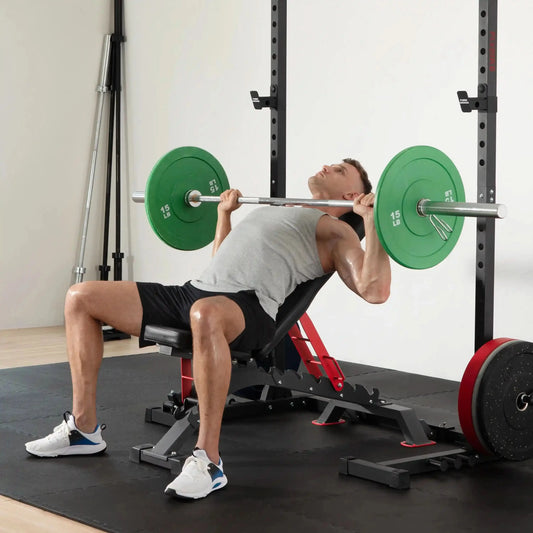When your chest workout day feels disorganized, you might ask yourself: How many chest exercises should I really be doing? Some lifters hammer endless bench presses, others jump between four or five different moves, and many aren’t sure whether any of it actually works.
This article clears up that confusion. You’ll learn how many chest exercises to do per workout based on your skill level, how to balance weekly training volume, and which movements target specific chest regions for maximum growth.
How Many Chest Exercises Per Workout Are Best?
Although it may seem that increasing exercise will yield even better results, research and experience contradict this impression. When examining the results of research related to resistance training volume, you will see that a moderate number of exercises, two or three per session, represents an ideal point between hard work and rest-promoting recovery. You are can maintain the quality of your series, achieve a weekly volume, and even recover enough to make gains when exercising at this point.
Balance Exercise Count With Weekly Set Targets
Training should be varied to achieve proper levels of exercise variety and overall volume. Studies involving hypertrophy demonstrate 10-20 sets per week focusing on exercises for the chest, which is ideal, but this is contingent on training experience.
-
Beginners require training with 1-2 exercises per session, resulting in 6-10 sets per week. Here, fewer exercises are better, as they are efficient in learning proper technique and allow faster recovery.
-
Intermediate lifters can perform 2-3 exercises per session and complete 10-16 sets a week. They are well-suited to training their chest muscles from various angles, but are not limited by muscular fatigue.
-
Advanced athletes could include 3 exercises per session, progression to 12-20 sets per week, as their restoration, technique, and intensity regulation are better. This will make sure that all areas of the chest are targeted effectively, whether with flat, incline, or fly exercises.
Click to learn more: How do I determine my bench press level?
So, it will be seen that the number of exercises and the overall number of sets increase slowly as you gain expertise.
Match Exercise Angles To Pec Regions
Although the bench press is a well-established muscle builder for the chest, this does not necessarily make it the best or only exercise to consider. It all comes down to the angle at which you press the weights, which should be tailored to your body type and training goal. A flat press will effectively target the middle to lower fibers. A slight incline of 15-30° will emphasize the upper pecs, and anything steeper will increasingly engage the front deltoids rather than the pecs.
“If you feel any pain or discomfort in the shoulders with the barbell bench press or prefer training at home, you can replace this exercise with dumbbell presses, machine presses, or weighted push-ups. Start every workout with a preferred pressing motion, such as flat, incline, or bodyweight exercises, and follow it up with a second pressing motion at a different angle. Finish your workout with a fly or a crossover move to stretch the pecs while they are under tension.”
Such a workout structure helps build the chest effectively while exercising within limitations, rather than limiting oneself through excessive training.
Use “How Many Chest Exercises Per Workout” As A Check
On balance, treat the phrase as a guardrail, not a rule. If you can’t progress load or reps on your main movement, you’re likely doing too much. If you’re fresh and still setting rep PRs, you can add a set or a third movement. The key is steady progression inside recoverable volume.
Which Chest Muscles Drive Your Exercise Choices?
The pectoralis major includes two key regions—the upper (clavicular) and the mid-lower (sternocostal). Even small changes in bench angle can shift which area takes on more of the load.
Understanding Upper Pec Mechanics at Modest Inclines
Gentle inclines emphasize the upper pec without turning the exercise into a shoulder press. Keep your bench set between 15–30 degrees, retract and depress the shoulder blades, and focus on driving your elbows inward and across to maintain tension on the chest. If your front delts start to take over, reduce the incline or opt for dumbbells to allow a freer, more natural arm movement.
Favor Flat Pressing for Overall Chest Development
The flat bench press—whether with a barbell or dumbbells—works the chest through a solid range of motion and makes it easier to track strength progress. Use the flat press as a mainstay for several weeks, then shift to a slight incline cycle to better target the upper chest. Machines can help maintain smooth tension and make it safer to push close to muscular failure.
Protect Your Shoulders with Smart Setup and Controlled Range
Shoulder comfort is essential for long-term progress. Use a moderate grip, engage your lats to stabilize the joint, and control your range of motion—bring the bar to your chest with steady tension or a light touch. If you feel pain, don’t ignore it; adjust your grip width, bench angle, or exercise variation to find a pain-free movement path.
Weekly Chest Volume and Frequency: Finding a Balance Point
A better chest will be achieved through fewer marathon training sessions and a greater concentration on how you adapt quality volume throughout the week. The plan is to train hard enough to create growth, yet not so hard as to sacrifice performance.
How Much Weekly Work Do You Need
Based on research and coaching experience, a lifter will usually see the greatest amounts of gains with 10–20 intensive chest training sets, completed over one to three training days each week. A novice lifter will often make the best gains with 6–10 cumulative sets, while an advanced lifter may aim closer to 20 if recovery, rest, and nutrition are well managed.
Why Splitting Volume Improves Results
When you accumulate all your exercises for the week into one session—commonly termed “chest day”—it often leads to late-set fatigue, characterized by poor form and reduced strength as the workout progresses. By dividing those sets into two shorter sessions, you conserve energy and maintain stronger output per set. For instance, you might train six sets on Monday and six on Friday instead of cramming twelve into one day, keeping both quality and intensity higher.
Chest Exercise Organization Guidelines
Pair chest exercises with suitable muscle groups to improve balance and recovery:
-
Push Day Split: Chest, shoulders, and triceps—a natural fit for pressing exercises.
-
Upper/Lower Split: Ideal for those training four days per week.
-
Full-Body Split: Great for beginners needing frequent practice with lighter loads.
Match your split to your schedule and recovery, not an arbitrary “perfect” template. Simplicity usually beats complexity.
Adjusting When Recovery Lags
If you experience shoulder discomfort, elbow soreness, or notice a slowdown in bar speed, ease off for a week by cutting back either training frequency or total volume. Once performance begins to rebound, gradually increase the workload again. Real progress isn’t about doing more—it’s about doing better and fully recovering between sessions.
Which Chest Exercises Should You Prioritize First?
A well-rounded chest routine is a matter of the same physics as a well-constructed building: beginning with the heavy structure and later focusing on detail work. The chest muscle group is comprised of various fiber areas, which are optimally stimulated by a combination of heavy compound presses and light isolation exercises.
Compound exercises, including
barbell or dumbbell presses, will target the highest number of muscle fibers simultaneously, allowing you to lift the heaviest weights. Such compound exercises will create the largest stimulus for overall growth and development. After targeting your chest through a primary pressing exercise, varying the
angle of push, as you move from a flat to an incline or decline press, will help you target other fibers left untouched by your initial exercise.
Isolation exercises, such as Cable or Dumbbell Flyes, are finally included as they are part of finishing a muscle by stretching and contracting, rather than stressing joints heavily.
Practical Application
-
Main Lift First: Begin a heavy barbell or dumbbell press to work the body’s largest fibers.
- Change the Angle Second: Perform an incline press, a decline press, or dips to effectively work the complete region around the chest.
-
Add Constant Tension: Finish an exercise with cable flyes or a pec deck, targeting deep stretch and contraction.
-
Use Machines for Safety: Machines enable a controlled failure, which doesn’t pose a threat
-
Track Your Loads: Tracking your exercises by weight and number of repetitions each week will allow you to progress
-
Stop at Quality Decline: It is better to end a training session if technique or pace wavers than to continue building quantity at the expense of quality,
What Rep Ranges And Loads Build Chest Fast?
Muscle growth happens effectively across a broad range of 5–30 reps, as long as the sets are challenging. Heavier ranges tend to build strength more quickly, while moderate ranges are easier on the joints and excellent for muscle size.
Use Moderate Loads for Most Hypertrophy
For steady muscle growth, stick mostly to 6–12 reps on your secondary presses and fly movements. This range allows a controlled stretch and smooth tempo, helping you generate plenty of tension without beating up the joints you’ll rely on for years of training.
Reserve Heavy Triples for Strength Phases
Working in the 3–5 rep range on your main pressing movement is great for refining technique and developing peak strength. Take longer rest periods and stop one rep short of failure—this keeps bar speed crisp and your weekly progress consistent.
Track Effort with Reps in Reserve
Keep most of your working sets within 0–2 reps in reserve (RIR)—that means finishing a set when you could only manage one or two more good reps. If you end a set knowing you had four or more reps left, add a bit of weight next time. If you struggle and your form breaks down, back off slightly.
Should You Train To Failure For Chest Gains?
You don’t need to train to failure on every set—stopping just shy of it produces nearly identical muscle growth while cutting down on fatigue.
Save Failure for Machines or Final Sets
Reserve true failure for safer, more controlled movements like the pec deck, cable flyes, or the last isolation set of a workout. Keep your free-weight presses around 0–1 reps in reserve (RIR) to get the growth stimulus without overwhelming your recovery system.
Manage Fatigue to Sustain Progress
Excessive training to failure reduces your total volume and slows bar speed—two key factors in muscle and strength gains. Use it purposefully within structured blocks so you can continue adding weight or reps week after week.
Program Failure Strategically in Mesocycles
Include higher-effort weeks right before a planned deload. Treat failure as a targeted training tool, not a constant habit. Long-term progress comes from steady improvement over months, not burning out after a handful of heroic sessions.
What Mistakes Sabotage Results On Chest Day?
Therefore, most stalls come from doing too many similar moves, rushing rest, or choosing angles that shift work off the pecs. Fix the basics first.
-
Overstuffed Menus: Five or six chest moves kill quality.
-
Short Rest Intervals: Use long rest intervals on heavy presses.
-
Steep Inclines: High angles turn presses into shoulder work.
-
Skipping Progression: No tracked jumps means no growth.
-
Ignoring Pain Signals: Adjust angles or tools to protect joints.
-
Chasing Burn Over Load: Pumps are fine; progression wins.
-
Random Volume Swings: Keep a steady chest workout plan.
How Can You Progress Chest Workouts Over Time?
Namely, use simple rules that scale. Add reps first, then load, then occasional sets.
Add Reps Before Adding Load
In turn, run a double‑progression: add reps within a range until you hit the top, then nudge the weight up. This keeps the technique crisp while strength and size climb.
Increase Weekly Sets Cautiously
Moreover, bump 2 sets per week at a time if you’re recovering well and still setting PRs. If performance dips for two straight weeks, pull 2–4 sets and sleep more.
Deload When Performance Stalls
Finally, a one‑week deload with lower volume and RPE refreshes joints and motivation. Return lighter and beat prior numbers within two weeks.
How Do Short Workouts Hit The Chest Efficiently?
Specifically, two hard sets on your main press plus a brief accessory can build muscle if you push near‑failure and log steady progress.
Two Hard Sets Main Press: Heavy, 0–1 RIR, full rest.
Second Press Or Push‑Ups: Near failure, faster setup.
One Isolation Finisher: Slow stretch, steady squeeze.
Clock The Session: 25–35 minutes, in and out.
Progress One Variable: Reps, load, or a third set.
Where Can Fed Fitness Help Your Chest Training?
Additionally, a sturdy bench and adjustable dumbbells make pressing safer and progression easier at home. Explore our
weight benches and a range of
adjustable dumbbells to outfit an efficient chest setup you’ll actually use.
Choose a Gear That Supports Good Angles
Notably,
adjustable bench let you lock in the 15–30° inclines that favor the upper chest without overloading the delts. Stable pads and secure hooks help you focus on execution, not wobble.
Build A Simple, Repeatable Home Setup
Moreover, adjustable dumbbells keep load jumps small, so you can progress every week without clutter. When gear is ready and reliable, consistency soars—and so do results.
Conclusion
In short, two or three chest exercises per workout is the sweet spot for most lifters. Keep your weekly total near 10–20 sets, use angles that match your goals, rest long enough to protect performance, and progress reps or load over time. If you keep asking How Many Chest Exercises Per Workout, let the answer be your guardrail: fewer, better moves done hard. When you’re ready to build a reliable home setup, visit FED Fitness for simple gear that helps you train well, week after week.












